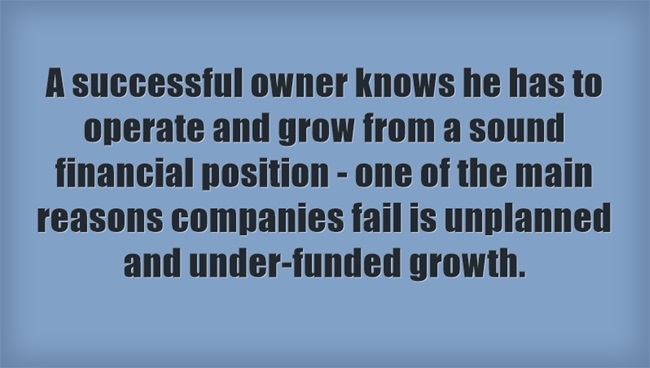There are many “things” a business owner needs to grow a company successfully. Some of them include equipment/machinery, warehouse/office/shop floor space, trucks, a new product line, land, etc. In a profitable business, the money for buying these things should come from capital investments.

He understands the financial health of his company is dependent on creating and following a plan which will generate the capital investment money he needs.
Here are three things to help you make a practical capital expenditure plan.
Understand Operational vs. Capital Expenses
Remember – You want to operate and grow from a position of strength. To do that you need to understand your financials, especially the difference between operational and capital expenditures.
Operational money is used to pay the monthly costs – i.e., the things you need to keep the business up and running. Such things include: electric, insurance, payroll, maintenance, office supplies, materials, taxes, rent/mortgage, etc. These are mostly assets which are bought and used up, typically within the same tax year.
Capital investment money is used to buy a different type of asset (see list above). It buys things that are supposed to provide financial benefits over a longer time frame and are usually depreciated over the years. For example, A back-hoe is a capital expense, while the gas, driver, and tune-ups are operational ones.
Budget Separately
Since operational and capital money is used for different purposes, it should be kept separate. They are not interchangeable pools of money. Short term money (operational) should not be used to finance long term projects/items (capital). Long term projects/items (capital) should not be financed if there is no short term money (operational) to support them.
Capital investments are commonly expensive, and their ROI is measured by years, which is why it is crucial for companies to budget for them carefully. It is a balancing act that smart owners learn how to control. They do not sacrifice short term stability for possible future gain.
You would be surprised by the number of owners who are ham-strung by profit-draining buildings, land, and equipment. After all, what good is a new CNC machine if you cannot afford the labor to run and maintain it? Or have enough sales/customers to pay for it.
Protect Cash Flow
Healthy businesses must have good cash flow; it is their life’s blood. Poor capital investments can limit or stop positive cash flow. Capital expenditures impact operational expenses as the purchased item needs operational money to support it. Knowledgeable owners understand how to dovetail their operational and capital requirements, making sure each one supports the other.
Protect your cash flow, and start your plan, by thoroughly answering each question. Your goal is to factually prove (no guesses, hopes or feelings) that the item to be purchased is worth the risk and cost. Confirm with at least one other knowledgeable, unbiased person that your risk assessment is accurate.
- How much of a profit can I expect on my investment and when will I start to see it? Depending on the item figure it out for each year of the next 5-10 years.
- What are the tax advantages and liabilities?
- What is my break-even? Have I added in all operational costs?
- Is leasing a better option than buying?
- Can the funds come from the company budget or will I need financing? What facts do I have that the debt can be served?
- How is my cash flow safe-guarded? What specific steps have I taken?
- Do the numbers, economy, my competition and customer demand support investing now or waiting for a future time?
There is a line where capital investment crosses from being a calculated risk to being a rash decision, where profit turns into a loss. This is also the line which separates you from achieving your dreams or not.
At Cogent Analytics, we never stop looking for ways to improve your business and neither should you. So, check out some of our other posts for helpful business information:



